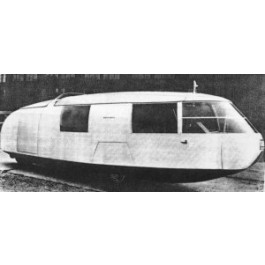Browse By
|
DymaxionDescriptionIn the late 1920’s experiments were being undertaken to test aerodynamics. One result of these test was three prototype Dymaxion 3-wheelers built by the 4D company in the USA. Richard Buckminster Fuller conducted wind-tunnel test on three-wheeled teardrop shapes with a V shaped groove running under the vehicle. A rudder was also added to the vehicles and Fuller intended that this would unfold from the upper side of the tail and provide stability. In 1933 Fuller hired Starling Burgess, an naval architect and a crew of expert sheet metal workers, woodworkers, former coach builders and machinist and they designed and built Dymaxion Car Number One which was shown publicly in July 1933. As a result of enclosing all the chassis and wheels in a streamlined shape Fuller is reported to have driven at 120 mph with a 90 hp engine. A conventional 1933 car would have required, Fuller estimated, at least a 300 hp engine. Fuller also claimed that fuel consumption of the Dymaxion car Number One was 30% less than a conventional car at 30mph and 50% less at 50mph. Detailed Information
|





